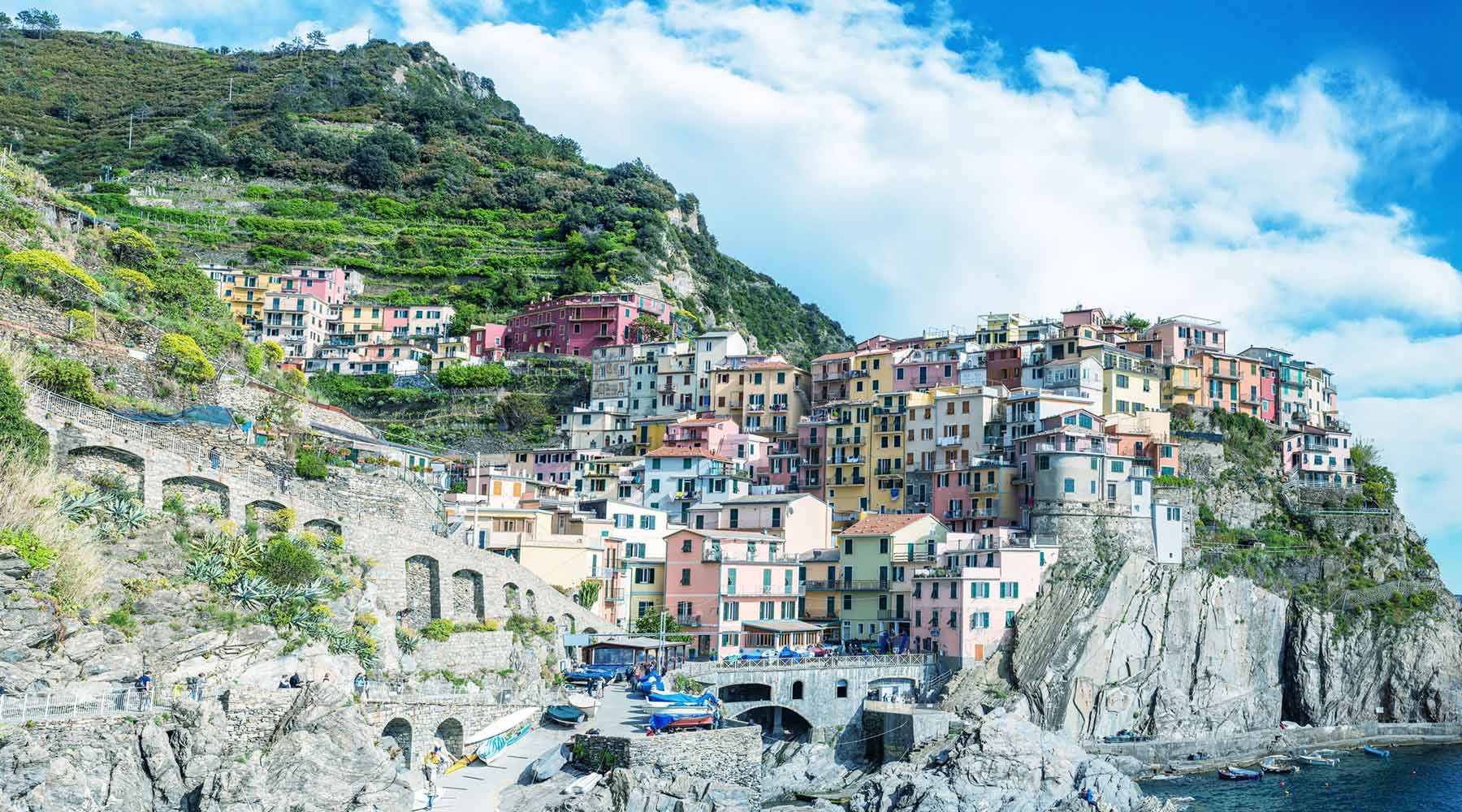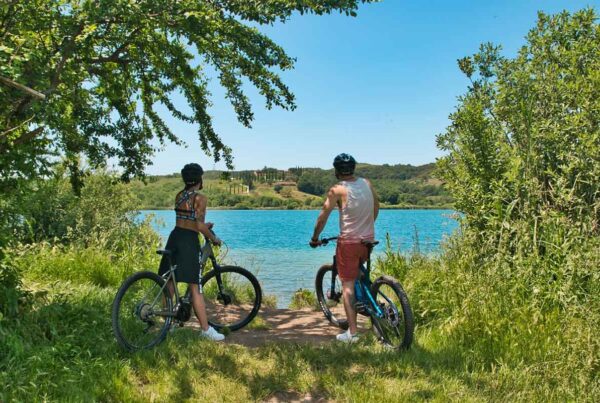The Cinque Terre and Sanremo
The famous Italian crescent-shaped section on the Tyrrhenian coast, where the Alps and the Apennines plummet down to the sea, is defined by its sinuous and vertiginous landscapes.
The Italian Riviera, synonymous with the Ligurian region, is shaped by its extreme terrain – daily life is a series of continual ascents and descents, with the sea omnipresent on the horizon The Riviera fans out on either side of the regional capital Genoa and is home to many beautiful destinations including the Portofino peninsula, the legendary Cinque Terre and picturesque Sanremo, famous for its Italian music festival and fun nights out in the casinos.
What to see in the Cinque Terre
Perched on the cliffs and surrounded by Mediterranean scrubland are the five small villages of Riomaggiore, Manarola, Corniglia, Vernazza and Monterosso which together make up the Cinque Terre. Located on the eastern side of Liguria, they are one of the most beautiful and evocative spots on the coast.
Their location, sandwiched between rugged mountains and the sea, sheltering them from cold winds and favouring a mild climate all year round, has on the one hand made it difficult for people to settle here over the centuries, but on the other, is precisely why they are so charming.
The towns are laid out vertically, with the typical tower-houses, which are taller than they are wide, painted in bright shades of yellow and pink, overlooking the sea, contrasting with the deep blue of the sea and the vegetation. The area around them, however, is densely covered by a system of terraces, known as ciàn, supported by dry stone walls, on which there are vegetable gardens, vineyards, olive groves, stairs, farmhouses and mule tracks.
Each village in the Cinque Terre has its own special features, with buildings and monuments that recount their centuries-old history. The best way to visit them is on foot following the many paths that run along the coast. There is, however, a train service that makes it quick and easy to go from one town to the next.
The most famous path is the Sentiero Azzurro (Blue Path), which connects the five villages along a 12-kilometre route, renowned for the splendid Mediterranean backdrop overlooking the sea. The first stretch, in particular, between Riomaggiore and Manarola, is called the Via dell’Amore (The Way of Love): a trail about one kilometre long offering tantalising glimpses of the sea, unspoilt nature and romantic views, especially at sunset.
Riomaggiore. It is the first town in the Cinque Terre when you arrive from La Spezia. Set between two terraced hills that plunge down to the sea, it is laid out vertically, criss-crossed by alleys and stairways that separate the typical tall, narrow tower-houses, painted yellow or pink and topped with slate roofs. It dates back to the 13th century when the inhabitants, who had settled inland, swore allegiance to the Republic of Genoa and moved nearer to the sea from where they developed faster and safer trade routes.
Riomaggiore is home to some fine monuments, such as the Church of San Giovanni Battista in the upper part of the town, built in 1340, with three naves featuring pillars in different styles and two Gothic doors; the 16th-century Oratorio di Santa Maria Assunta, which houses a 15th-century triptych and a 14th-century wooden statue of the Madonna; and the Castle that dominates the historic centre.
Manarola. A small district of Riomaggiore, it is perched on a steep promontory of dark stone, with its small harbour enclosed between two rocky spurs. Here again the town is built vertically, where the typical tower-houses seem to emerge from the sheer rock, set in the hills behind vineyards and olive groves. Founded during the 12th century, the history of the town is linked to the Fieschi family of Lavagna, who lost control of it after being defeated by the Republic of Genoa. Its name probably derives from an ancient “magna roea”, meaning a large water mill wheel of which evidence remains of an old mill in the lower part of the town.
The heart of Manarola is Piazza Papa Innocenzo IV, where the most important historical monuments are located. These include the Church of San Lorenzo, built in 1338 in the Ligurian-Gothic style, consisting of three naves, with a Baroque interior illuminated by a large white marble rose window opening onto the façade; the 14th-century Campanile Bianco (white bell tower) with a square layout, unusually detached from the church probably because it was used as an ancient watchtower and defence tower; the 15th-century Oratorio dei Disciplina; and the ancient Ospedale di San Rocco. The town is criss-crossed by a maze of narrow streets and stairs that pass between the houses, leading up to the via del Belvedere or down to the small harbour and marina where you can have a swim among the rocks.
Corniglia. Unlike the other towns, Corniglia lies on the top of a promontory about 90 metres above sea level and consequently is the only one without a harbour. To reach it, you have to climb the “Lardarina”, a long brick staircase of 33 flights and 377 steps that leads from the town to the railway station and the sea. Alternatively, you can take a bus operating between the station and the small town.
Largo Taragio lies at the heart of Corniglia, the small main square offering a spectacular view of the sea and aptly nicknamed “the terrace”, overlooked by the Oratorio dei Disciplinati, dating back to the 18th century. From here, a long flight of steps leads to the small port of Corniglia with only rocks. Alternatively, you can take a 15-minute walk through an old disused railway tunnel to the Guvano beach, which is much more appealing with a mixture of sand and pebbles.
Vernazza. It is the only natural harbour in the Cinque Terre created by a rocky outcrop that extends into the sea and on which the town was built. This may also be why it is considered by many to be the most stunning, where the typical colourful tower-houses are more graceful in shape and adorned with decorations and porticoes testifying to a high economic and social level. The town is dominated by the remains of the “castrum”, a series of medieval fortifications including the Doria castle and a cylindrical tower dating back to the 11th century, while the town is crossed by a single central street from which steep stairways known as “arpaie” open out at right angles.
The most important building is the Church of Santa Margherita di Antiochia, built in the 13th century in Romanesque-Genoese style, with large trefoil windows and consisting of a medieval and a Renaissance body. At its foot, you can follow the narrow road down to the small harbour and marina where you can take a dip in the turquoise waters of the natural inlet.
Monterosso al Mare. Divided in two parts by the hill of San Cristoforo, it is the largest town in the Cinque Terre and probably also the oldest. The historic centre is situated on one side with the remains of the 13th century castle, owned by the nobles of Lagneto, and other fortifications to counter Saracen incursions, forming the most impressive defence system in the Cinque Terre. Take the time to visit the 14th-century church of San Giovanni Battista, in Gothic-Genoese style, with its two-coloured façade, or the hilltop Fieschi castle and monastery on the colle dei Cappuccini with the church dedicated to Saint Francis, with paintings attributed to Van Dick, Cambiaso, Piola and Guido Reni.
The newest part is Fegina, popular with tourists because it has the largest beach in the Cinque Terre. This is the location of Villa Montale where Eugenio Montale, the Nobel Prize winner for Literature, stayed and found inspiration for many of his famous verses in this “rocky and austere village, an asylum of fishermen and peasants”. The building is now the centre of the “Parco Letterario” dedicated to the poet and writer, in which several paths lead, between the land and the sea, through the places in Monterosso that were dearest to him.
What to do in Sanremo
A popular destination on the western side of Liguria is Sanremo, the City of Flowers and Music, set in the lovely Riviera dei Fiori, with its historic centre full of attractions and the lovely palm-shaded promenade.
The Casino, beautiful villas, churches, the shopping area of Corso Matteotti with the famous Ariston Theatre, the gardens and beaches make it a perfect destination for a day trip.
The city has two sides to it: the lively and modern one and the ancient and fascinating one of its historical districts, La Pigna, the original centre of the medieval city that can be reached by passing through the 14th-century Porta di Santo Stefano. The new part is home to the renowned Sanremo Casino, an elegant Art Nouveau building inaugurated in 1905 and reopened in 1945 at the end of World War II.
The city’s churches are also impressive, including the Cattedrale di San Siro and the Russian Orthodox Church. The Cathedral dates back to 811 and is the most important example of Romanesque architecture in Liguria.
The Russian Orthodox Church, on the other hand, is one of the city’s symbols and an authentic masterpiece. It was built at the beginning of the 20th century with eye-catching, classic round, coloured domes in an architecture style that differs greatly to all the other buildings in Sanremo.
Not to be missed are the two magnificent historic villas, Villa Nobel and Villa Ormond. The former is named after Alfred Nobel, the inventor of the Nobel prize who stayed here, and was built in 1870 in Moorish style. The three-storey building houses Nobel’s study, rooms with frescoed ceilings and is preceded by a large courtyard with exotic plants.
Villa Ormond, on the other hand, has a 19th-century garden in which you can admire a wide variety of exotic plants, laid out in sections, including rare and very old specimens.
As you stroll along Corso Matteotti, your gaze is drawn to the famous Teatro Ariston, home to the Italian Song Festival and the Tenco Award, a unique theatre that can seat up to two thousand people and, throughout the year, offers countless performances such as opera, ballet, cabaret, cinema and poetry.
Another place worth visiting is the Civic Museum in the city centre, which houses the remarkable historical, artistic and archaeological heritage of Sanremo and the Ponente area, with ancient artefacts from the area displayed alongside the picture gallery exhibiting fine works by sculptors and painters from the 17th century to the present day.
Lastly, Sanremo is also a wonderful seaside resort with an impressive seafront promenade, the Empress Promenade, named in honour of the Russian Tsarina Maria Alexandrovna, featuring a line of tall palm trees and benches where you can take a well-earned break among sculptures and manicured flowerbeds, the cycling path and the two city beaches.
The Spiaggia dei Porti, with its fine white sand, is close to the city centre between Porto Sole and Porto Vecchio, while the Spiaggia Tre Ponti, further out, is shaped by pebbles and rocks.
Both have bathing facilities with children’s playgrounds, restaurants and sports activities.








